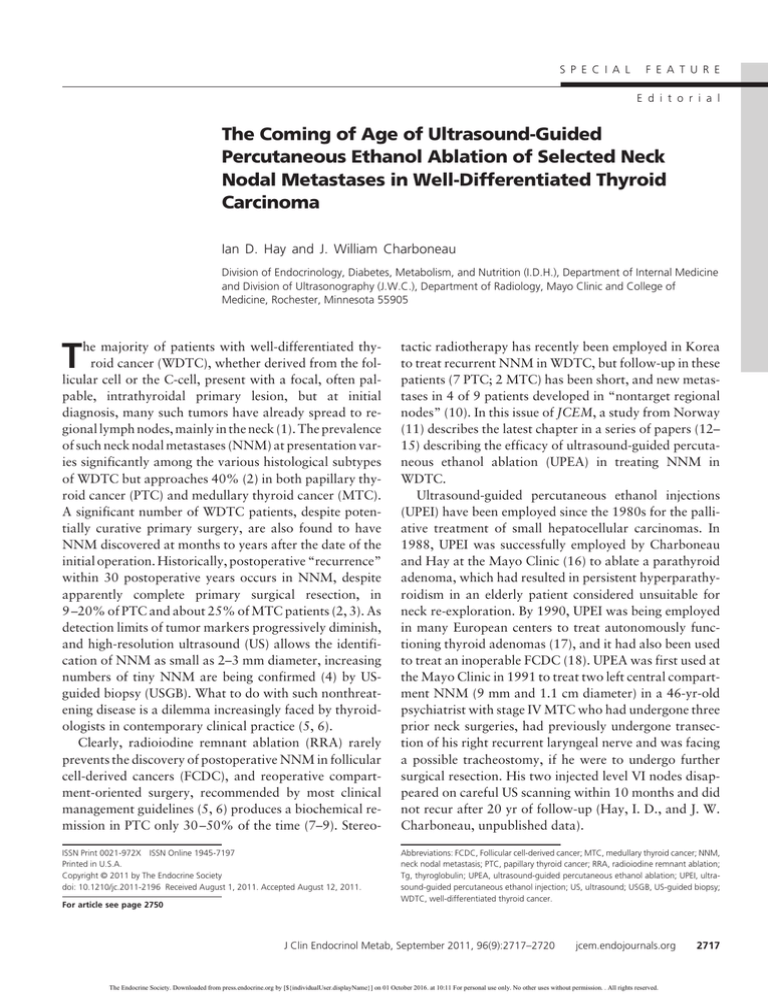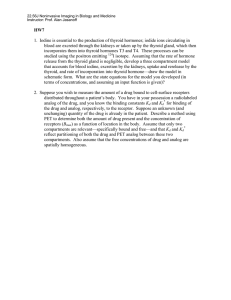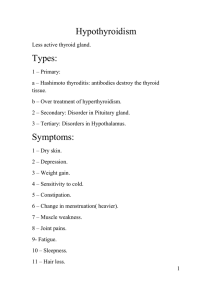
S P E C I A L
F E A T U R E
E d i t o r i a l
The Coming of Age of Ultrasound-Guided
Percutaneous Ethanol Ablation of Selected Neck
Nodal Metastases in Well-Differentiated Thyroid
Carcinoma
Ian D. Hay and J. William Charboneau
Division of Endocrinology, Diabetes, Metabolism, and Nutrition (I.D.H.), Department of Internal Medicine
and Division of Ultrasonography (J.W.C.), Department of Radiology, Mayo Clinic and College of
Medicine, Rochester, Minnesota 55905
T
he majority of patients with well-differentiated thyroid cancer (WDTC), whether derived from the follicular cell or the C-cell, present with a focal, often palpable, intrathyroidal primary lesion, but at initial
diagnosis, many such tumors have already spread to regional lymph nodes, mainly in the neck (1). The prevalence
of such neck nodal metastases (NNM) at presentation varies significantly among the various histological subtypes
of WDTC but approaches 40% (2) in both papillary thyroid cancer (PTC) and medullary thyroid cancer (MTC).
A significant number of WDTC patients, despite potentially curative primary surgery, are also found to have
NNM discovered at months to years after the date of the
initial operation. Historically, postoperative “recurrence”
within 30 postoperative years occurs in NNM, despite
apparently complete primary surgical resection, in
9 –20% of PTC and about 25% of MTC patients (2, 3). As
detection limits of tumor markers progressively diminish,
and high-resolution ultrasound (US) allows the identification of NNM as small as 2–3 mm diameter, increasing
numbers of tiny NNM are being confirmed (4) by USguided biopsy (USGB). What to do with such nonthreatening disease is a dilemma increasingly faced by thyroidologists in contemporary clinical practice (5, 6).
Clearly, radioiodine remnant ablation (RRA) rarely
prevents the discovery of postoperative NNM in follicular
cell-derived cancers (FCDC), and reoperative compartment-oriented surgery, recommended by most clinical
management guidelines (5, 6) produces a biochemical remission in PTC only 30 –50% of the time (7–9). Stereo-
tactic radiotherapy has recently been employed in Korea
to treat recurrent NNM in WDTC, but follow-up in these
patients (7 PTC; 2 MTC) has been short, and new metastases in 4 of 9 patients developed in “nontarget regional
nodes” (10). In this issue of JCEM, a study from Norway
(11) describes the latest chapter in a series of papers (12–
15) describing the efficacy of ultrasound-guided percutaneous ethanol ablation (UPEA) in treating NNM in
WDTC.
Ultrasound-guided percutaneous ethanol injections
(UPEI) have been employed since the 1980s for the palliative treatment of small hepatocellular carcinomas. In
1988, UPEI was successfully employed by Charboneau
and Hay at the Mayo Clinic (16) to ablate a parathyroid
adenoma, which had resulted in persistent hyperparathyroidism in an elderly patient considered unsuitable for
neck re-exploration. By 1990, UPEI was being employed
in many European centers to treat autonomously functioning thyroid adenomas (17), and it had also been used
to treat an inoperable FCDC (18). UPEA was first used at
the Mayo Clinic in 1991 to treat two left central compartment NNM (9 mm and 1.1 cm diameter) in a 46-yr-old
psychiatrist with stage IV MTC who had undergone three
prior neck surgeries, had previously undergone transection of his right recurrent laryngeal nerve and was facing
a possible tracheostomy, if he were to undergo further
surgical resection. His two injected level VI nodes disappeared on careful US scanning within 10 months and did
not recur after 20 yr of follow-up (Hay, I. D., and J. W.
Charboneau, unpublished data).
ISSN Print 0021-972X ISSN Online 1945-7197
Printed in U.S.A.
Copyright © 2011 by The Endocrine Society
doi: 10.1210/jc.2011-2196 Received August 1, 2011. Accepted August 12, 2011.
Abbreviations: FCDC, Follicular cell-derived cancer; MTC, medullary thyroid cancer; NNM,
neck nodal metastasis; PTC, papillary thyroid cancer; RRA, radioiodine remnant ablation;
Tg, thyroglobulin; UPEA, ultrasound-guided percutaneous ethanol ablation; UPEI, ultrasound-guided percutaneous ethanol injection; US, ultrasound; USGB, US-guided biopsy;
WDTC, well-differentiated thyroid cancer.
For article see page 2750
J Clin Endocrinol Metab, September 2011, 96(9):2717–2720
jcem.endojournals.org
The Endocrine Society. Downloaded from press.endocrine.org by [${individualUser.displayName}] on 01 October 2016. at 10:11 For personal use only. No other uses without permission. . All rights reserved.
2717
2718
Hay and Charboneau
Neck Nodal Metastases in Well-Differentiated Thyroid CA
The first PTC patient treated with UPEA at Mayo was
a 34-yr-old woman who had previously undergone a
total thyroidectomy and left radical neck dissection,
successful remnant ablation with 135 mCi of 131I and,
additionally, 5400 cGy of external irradiation (12). Despite this aggressive initial therapy, she was left with a
32 ⫻ 10 ⫻ 10 mm mass of tumor adjacent to the left
carotid bulb, deemed to be inoperable. Over a period of 10
months, during May 1993 through March 2004, this patient received a total of 1.4 cc of 95% ethanol by USguided injections over three sessions. Now, at 18 yr after
first treatment, her serum thyroglobulin (Tg) is ⬍0.1 ng/
ml, her whole-body 2-fluoro-2-deoxy-D-glucose positron
emission tomography-computed tomography scan is negative and her latest US only shows an avascular node of 6 ⫻
5 ⫻ 8 mm adjacent to the left common carotid artery.
Between November 1993 and April 2000, a further 13
PTC patients, who had undergone adequate primary surgical resection and postoperative RRA, presented to Mayo
Clinic with a limited number of “recurrent” NNM (one to
five involved nodes). Twenty-nine NNM in these 14 study
patients were treated during 1993–2000 with UPEA (12).
Mean follow-up was 18 months (range, from 2 months to
6 yr 5 months). All treated nodes decreased in volume
(from a mean volume of 492 mm3 at treatment to a mean
of 20 mm3 after 2 yr); blood flow within the NNM, as
measured by color Doppler, was totally eliminated. In 12
(86%) of the 14 patients, UPEA successfully controlled all
known metastatic adenopathy. The other two patients developed further NNM at 19 and 26 months after successful UPEA, and these later-onset nodes were considered
anatomically unsuitable for alcohol ablation and were
successfully treated by surgical resection. Most patients
experienced brief discomfort at the injection site, but none
developed transient or permanent hoarseness.
Lewis and colleagues (12) concluded that UPEA was a
valuable treatment option for patients with limited NNM
from PTC who were not amenable to further surgical or
radioiodine therapy. They emphasized that UPEA was far
less invasive than neck re-exploration, could be repeated
without technical difficulty, and required minimal recovery time. At the time of their 2001 manuscript acceptance
(12), the procedural cost for a single UPEI was $836, as
against costs of approximately $9,800 –$12,000 for surgical neck exploration. Almost a decade later, the average
charge for each of 75 UPEA procedures (current procedural terminology code 38999), performed during 2010 at
Mayo for 53 patients with FCDC or MTC, was $1,583, a
fraction of the $35,000 to $45,000 charges estimated (including all hospitalization costs) for either a central compartment node dissection or a unilateral modified radical
J Clin Endocrinol Metab, September 2011, 96(9):2717–2720
neck dissection (current procedural terminology codes
38720 or 38724).
The multidisciplinary thyroid team at the Norwegian
Radium Hospital (Oslo, Norway), apparently “inspired”
(11) by the promising results reported by Lewis et al. (12),
introduced UPEI to their practice in 2004. In the paper by
Heilo et al. (11), published in this issue of JCEM, they
describe their experience of treating 69 PTC patients during 2004 –2009. All of their patients had been treated with
thyroidectomy and RRA. Lymph node status was determined by USGB and/or by raised levels of Tg in washouts
from the cytological needle. Guided by US, 0.1 to 1.0 ml
of 99.5% ethanol was injected into each selected NNM.
Sixty-three patients with 109 NNM were treated and followed on average for 38 months (range 3–72).
In total, 101 of 109 (93%) of the NNM responded to
PEI treatment: 92 (84%) completely and nine incompletely. Two did not respond, and four progressed. Two
lymph nodes, previously considered successfully treated,
showed evidence of malignancy during follow-up. Serum
Tg values were available from 62 patients before PEI and
from 60 at the end of follow-up. Of 51 patients without Tg
antibodies, 13 had undetectable serum Tg levels (⬍0.2
g/liter) before PEI, despite biopsy-proven metastatic disease. Of the 38 patients with elevated serum Tg values
before PEI, 30 patients had undetectable values after PEI
treatment. Heilo et al. (11) concluded that UPEA seems to
be an excellent alternative to surgery in patients with a
limited number of NNM from PTC and should probably
replace “berry picking” surgery.
Potential complications of UPEA include damage to
recurrent laryngeal nerves, parathyroid injury, and local
pain or discomfort, likely related to local leakage of small
amounts of ethanol into surrounding soft tissue. To date,
very few complications have been reported. Of six PTC
patients treated with UPEA at Rhode Island Hospital
(Providence, RI), one experienced temporary hoarseness,
which recovered within 3– 4 h (13). One (6%) of 16 UPEItreated PTC patients from Yonsei University (Seoul, Korea) had “voice change,” which disappeared after 5 d (14).
In the 2008 report of Kim et al. (15), one of 27 PTC patients (4%) experienced temporary hoarseness after
UPEA. Lastly, in the present Norwegian study (11), no
major complications were recognized, and “less than
10%” of 63 treated PTC patients experienced minor local
discomfort.
With the publication of this Norwegian long-term follow-up study (11), there should now be little doubt about
the efficacy of UPEA in eliminating selected NNM in patients with PTC. Clearly, the technique, first described in
Minnesota (12, 16), has been successfully duplicated in
other parts of the United States (13), in Asia (14, 15), and
The Endocrine Society. Downloaded from press.endocrine.org by [${individualUser.displayName}] on 01 October 2016. at 10:11 For personal use only. No other uses without permission. . All rights reserved.
J Clin Endocrinol Metab, September 2011, 96(9):2717–2720
in Europe (11). In the Mayo practice, during 1991–2000,
more than half of the UPEA procedures were carried out
in stage IVC patients who had evidence of distant metastases, and, in these circumstances, the procedure was considered palliative. However, since 2001, more than 80%
of UPEA procedures have been performed in patients with
disease confined to the neck (pT1 or T2, N1a or N1b, M0),
where residual nodal disease was minimal, and the procedure
might potentially be considered as curative. Further longterm follow-up studies are indicated to determine whether, in
selected PTC cases, UPEA can significantly improve future
locoregional recurrence rates.
Clearly, there may always be a role for PUEA in palliation,
when selected patients with advanced WDTC, rather than
being appropriately concerned with potentially life-threatening distant metastases, become obsessed with the more
easily visualized (and treated) NNM. However, it should be
that much greater population of patients with localized nodepositive PTC, who have not experienced an optimized surgical approach (19) and have proved resistant to the still
probably over-used and relatively ineffective RRA (20),
that will probably most benefit from this safe, cheap, and
effective means of eliminating nonthreatening NNM in
PTC. Although the technique requires an ability to recognize pathologic NNM on high-resolution US and necessitates special skill in USGB of awkwardly situated and
increasingly small NNM, such skills can be learned, and,
globally, many interested clinicians are indeed presently
acquiring such talents in a variety of university and private
practice settings.
The current American Thyroid Association revised
Management Guidelines (5) conclude with a section entitled: “What are directions for future research?” Under
the section on “small cervical lymph node metastases,” the
authors state that “future research must consider the dilemma of minimizing iatrogenic patient harm vs. preventing cancer morbidity and (perhaps) mortality. Perhaps
techniques will be developed to safely remove or destroy
small cervical nodal metastases, which in some cases
would otherwise progress to overt, clinically significant
metastases” (5). There seems little doubt that UPEA has,
as of 2011, “come of age,” and certainly at Mayo, it has
found its place in the mainstream of techniques used to
treat and locally control recurrent nodes in PTC. With the
increasing numbers of international series being published, which reinforce the messages of the 2002 AJR paper (12), it is to be hoped that an increasing number of
institutions (particularly in North America), will encourage their physicians to develop similar skills comparable to
the radiologists in Rochester and Oslo, who have, in recent
years, provided a valuable service for their WDTC patients
with NNM considered to be “not amenable to conven-
jcem.endojournals.org
2719
tional retreatment with surgery, radioiodine, or external
irradiation” (12).
Acknowledgments
Address all correspondence and requests for reprints to: Professor Ian D. Hay, M.D., Ph.D., F.R.C.P., Division of Endocrinology and Internal Medicine, Mayo Clinic and College of Medicine, 200 First Street SW, Rochester, MN 55905. E-mail:
hay.ian@mayo.edu.
Disclosure Summary: No conflicts of interest exist.
References
1. Schlumberger MJ, Filetti S, Hay ID 2011 Non-toxic diffuse and
nodular goiter and thyroid neoplasia. In: Melmed S, Polonsky KS,
Larsen PR, Kronenberg HM, eds. Williams textbook of endocrinology. 12th ed. Philadelphia: Elsevier Saunders Company; 440 – 478
2. Grebe SK, Hay ID 1996 Thyroid cancer nodal metastases: biological
significance and therapeutic considerations. Surg Oncol Clin N Am
5:43– 63
3. Grebe SK, Hay ID 1997 Follicular cell-derived thyroid carcinoma.
Cancer Treat Res 89:91–140
4. Torlantano M, Attard M, Crocetti U, Tumino S, Bruno R, Costante
G, D’Azzò G, Meringolo D, Ferretti E, Sacco R, Arturi F, Filetti S
2004 Follow-up of low risk patients with papillary thyroid cancer;
role of neck ultrasonography in detecting lymph node metastases.
J Clin Endocrinol Metab 89:3402–3407
5. Cooper DS, Doherty GM, Haugen BR, Hauger BR, Kloos RT, Lee
SL, Mandel SJ, Mazzaferri EL, McIver B, Pacini F, Schlumberger M,
Sherman SI, Steward DL, Tuttle RM 2009 Revised American Thyroid Association management guidelines for patients with thyroid
nodules and differentiated thyroid cancer. Thyroid 19:1167–1214
6. Rondeau G, Tuttle RM 2011 Similarities and differences in follicular
cell-derived thyroid cancer management guidelines used in Europe
and the United States. Semin Nucl Med 41:89 –95
7. Al-Saif O, Farrar WB, Bloomston M, Porter K, Ringel MD, Kloos
RT 2010 Long-term efficacy of lymph node reoperation for persistent papillary thyroid cancer. J Clin Endocrinol Metab 95:2187–
2194
8. Schuff KG 2011 Management of recurrent/persistent papillary thyroid carcinoma: efficacy of the surgical option. J Clin Endocrinol
Metab 96:2038 –2039
9. Yim JH, Kim WB, Kim EY, Kim WG, Kim TY, Ryu JS, Gong G,
Hong SJ, Shong YK 2011 The outcomes of first reoperation for
locoregionally recurrent/persistent papillary thyroid carcinoma in
patients who initially underwent total thyroidectomy and remnant
ablation. J Clin Endocrinol Metab 96:2049 –2056
10. Kim JH, Kim MS, Yoo SY, Lim SM, Lee GK, Yi KH 2010 Stereotactic body radiotherapy for refractory cervical lymph node recurrence of nonanaplastic thyroid cancer. Otolaryngol Head Neck Surg
142:338 –343
11. Heilo A, Sigstad E, Fagerlid KH, Haskjold OI, Groholt KK, Berner
A, Bjoro T, Jorgensen LH 2011 Efficacy of ultrasound-guided percutaneous ethanol injection treatment in patients with a limited
number of metastatic cervical lymph nodes from papillary thyroid
carcinoma. J Clin Endocrinol Metab 96:2750 –2755
12. Lewis BD, Hay ID, Charboneau JW, McIver B, Reading CC, Goellner JR 2002 Percutaneous ethanol injection for treatment of cervical
lymph node metastases in patients with papillary thyroid carcinoma.
AJR 178:699 –704
13. Monchik JM, Donatini G, Iannucilli J, Dupuy DE 2006 Radiofre-
The Endocrine Society. Downloaded from press.endocrine.org by [${individualUser.displayName}] on 01 October 2016. at 10:11 For personal use only. No other uses without permission. . All rights reserved.
2720
14.
15.
16.
17.
Hay and Charboneau
Neck Nodal Metastases in Well-Differentiated Thyroid CA
quency ablation and percutaneous ethanol injection for recurrent
local and distant well-differentiated thyroid carcinoma. Ann Surg
244:296 –304
Lim CY, Yun JS, Lee J, Nam KH, Chung WY, Park CS 2007 Percutaneous ethanol injection therapy for locally recurrent papillary
thyroid carcinoma. Thyroid 17:347–350
Kim BM, Kim MJ, Kim EK, Park SI, Park CS, Chung WY 2008
Controlling recurrent papillary thyroid carcinoma in the neck by
ultrasonography-guided percutaneous ethanol injection. Eur Radiol
18:835– 842
Charboneau JW, Hay ID, van Heerden JA 1988 Persistent primary
hyperparathyroidism: successful ultrasound-guided percutaneous
ethanol ablation of an occult adenoma. Mayo Clin Proc 63:913–917
Livraghi T, Paracchi A, Ferrari C, Bergonzi M, Garavaglia G, Rai-
J Clin Endocrinol Metab, September 2011, 96(9):2717–2720
neri P, Vettori C 1990 Treatment of autonomous thyroid nodules
with percutaneous ethanol injection: preliminary results. Work in
progress. Radiology 175:827– 829
18. Goletti O, Lenziardi M, De Negri F, Fiorini I, Lippolis PV, Cristofani
E, Di Coscio G, Secia M, Cavina E 1993 Inoperable thyroid carcinoma: palliation with percutaneous injection of ethanol. Eur J Surg
159:639 – 641
19. Grant CS, Stulak JM, Thompson GB, Richards ML, Reading CC,
Hay ID 2010 Risks and adequacy of an optimized surgical approach
to the primary surgical management of papillary thyroid carcinoma
treated during 1999 –2006. World J Surg 34:1239 –1246
20. Hay ID 2006 Selective use of radioactive iodine in the postoperative
management of patients with papillary and follicular thyroid carcinoma. J Surg Oncol 94:692–700
The Endocrine Society. Downloaded from press.endocrine.org by [${individualUser.displayName}] on 01 October 2016. at 10:11 For personal use only. No other uses without permission. . All rights reserved.






